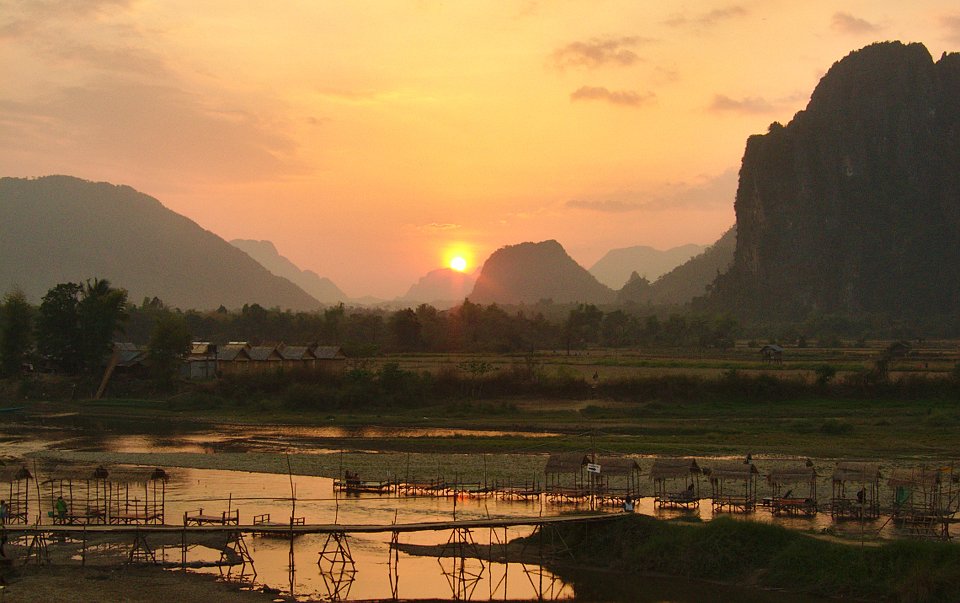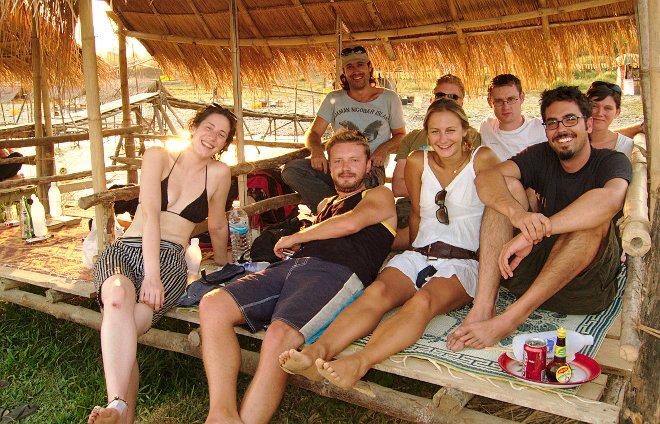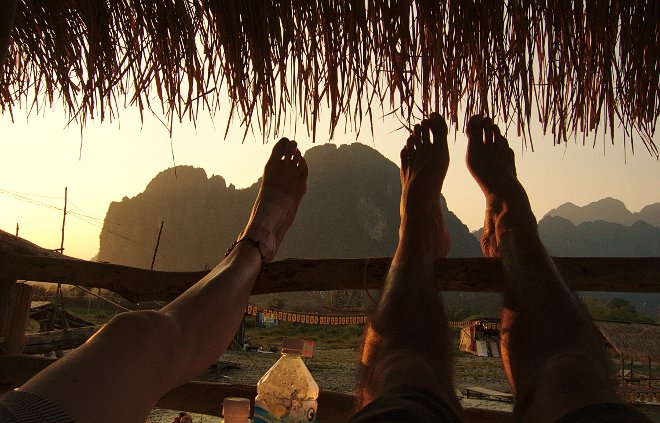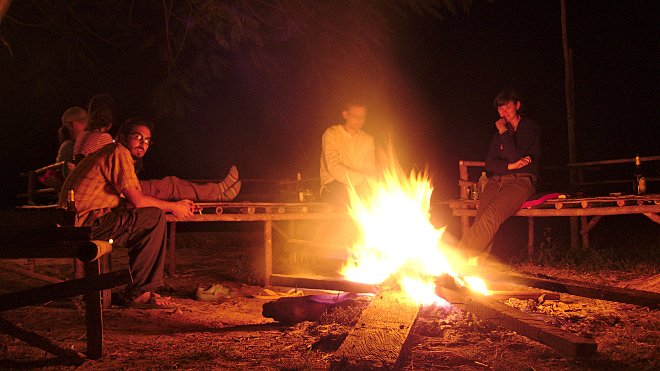The Lovely Universe
Because we didn’t find out about the Gibbon Experience until we were halfway to Luang Prabang, we ended up making a loop through northern Laos and in the end Robin, Ofir and I found ourselves once more in the border town of Huay Xai. Robin had to return to Thailand and then headed home to Sweden.
After talking it over for a while, Ofir and I decided that two more days on the slow boat back to Luang Prabang was marginally less miserable than taking the bus back over the dusty roads. Beside which the slow boat is good way to meet new people, so we ended up returning full circle to Luang Prabang.
As it turned out the second trip down the river was an entirely different experience. Our boat was not a talkative bunch and we didn’t meet anyone, but I did spend a good bit of time listening to music and contemplating the life the Strangler Fig Tree.
In the west (or America anyway) the Strangler Fig is more commonly known as the Banyan tree and is most notable for its long drooping roots (which make it ideal for building tree houses since it’s a very stable tree). But the most interesting thing about the Strangler Fig is how it grows. The seeds from a mature tree are eaten by arboreal animals that then deposit them (crap them out for the none scientific among us) in the branches of some unsuspecting and already full-grown tree. For a while the Strangler Fig lives a bit like an orchid (and is perhaps one of the reasons people think orchids are parasitic, but they aren’t) attached to the host tree, but not yet parasitic.
As the Strangler Fig grows its roots head downward, thin tendrils searching for the ground. When the roots finally reach the ground they dig in and begin to wrap around the host tree’s roots stealing its water and nutrients. From there the fig just sort of takes over and eventually the original tree dies, but you can generally still see the trunk buried somewhere under the roots of the full grown fig. The largest Banyan tree in the world is somewhere in India and occupies the better part of two acres, but in Laos, because the fig must reach up out of the jungle canopy to get light, the trees tend to be tall rather than spread out.
The fig is, though it may be a bit cynical to say so, is not unlike the ever growing tourism industry. One can almost see the way in which the first guest house in any given town started as a purely separate existence, an oddity growing in the branches of a village, but then, over time, the roots of travelers begin to squeeze out what was once a farming or fishing village, until at some point a critical mass is reached. Sometimes, as in case of Luang Prabang, it’s fairly easy to find that tipping point, things like the UNESCO seal of approval and the completion of an airport might well be the moment the roots of the original tree finally give in, the economy shifted and what remains is merely tourism, a fig tree in which an endless amount of guesthouses and western style restaurants begin to appear.
But perhaps the tree is best left simply as a tree, a good place to build a tree house if that is your inclination, or maybe just something to marvel out while you float down the same river that already took everything out of you; what’s left when everything is gone? Laos. Whatever the case Ofir and I had already decided we didn’t want to spend any more time in Luang Prabang.

The plan was to buy a bus ticket and then take it easy, eat an early dinner and catch up on some sleep. Of course when you’re traveling that’s easier said that done. We were sitting in small cafe on the main street in Luang Prabang when suddenly Ofir jumped up and took off down the street. I saw him talk for a while to someone and then the two of them came back over to the table and I met Andy, a German man Ofir had traveled with some months ago in India. Andy invited us to dinner (which is strange invitation to people eating dinner, but hey) with some people he had met on the slow boat two days before, which is the semi-convoluted way in which I met, Matt from Holland, Jackie, Keith, Matt from London, Georgia, and Debi. Of course the names mean nothing to you, so lets at least try it with a picture, from the back left corner: Ofir, Matt from Holland, Keith from Ireland, Jackie from Germany, Debi from London, Matt also from London, Georgia from Australia and me.

Ofir and I were headed for Vang Vieng and so was everyone else so we made plans to meet up at some point. After traveling more or less constantly for ten days over some very bad roads and very long rivers, Ofir and I arrived in Vang Veing with the intention of doing nothing for at least a week. After that we were planning to head back into Thailand. I had some work to do, articles to write and websites to build so the down time was good for me. Vang Vieng was a curious little town, a town where the strangler fig of tourism long ago squeezed out whatever the village used to be. But sometimes you need a bit of westernism. At this point Vang Vieng is chiefly famous for inner tubing trips down the river and its endless row of bars, the majority of which play old episodes of Friends from morning far into the night.

I spent the majority of my time in Vang Vieng lying back in a small thatched awning hut beside the river, feet kicked up, alternately reading, writing and watching the light change hues through the afternoon. In the evenings, just after sundown, the cliffs in the distance emitted a massive smoky-looking plume out the western cliff face—bats, thousands and thousands of bats heading out into the night sky. It was one of the more amazing sights I’ve witnessed in Laos and it happened so regularly you could set your clock by it.
When Andy and the rest of the larger group showed up, Ofir and followed them to new guesthouse which had nice sitting area, a free sauna, a great restaurant and cheap massages, which isn’t bad for three dollars a night (Thank you Georgia). I would like to say that I have something memorable to write about Vang Vieng, but the truth is we mostly sat around doing nothing, making new friends, drinking a beer round the fire at night.

The only thing I managed to do was make a day trip down to Vientiane with Debi. Debi had an infected cut on her foot and wanted to have it look at by real doctors at the Australian clinic and I need to extend my Laos visa, which is strange considering I was only planning on spending a few days here to renew my Thai visa. So it was that we found ourselves at the bus station at six thirty in the morning trying to make a day trip to the capital. After taking care of the various medical and paperwork necessities in Vientiane, we passed the afternoon drinking beer at massage/spa (yes that is a strange place to spend your afternoon drinking beer, but if I were to list all the strange places there wouldn’t be much else to write about). Having had no problem getting to Vientiane we assumed it would be no problem to get back, but such was not the case. Finally, after making a tuktuk powered tour of all three Vientiane bus stations, we finally found a bus back to Vang Vieng.
The piece of bad new we discovered on our day trip to Vientiane was that Chinese new years was in full swing and unlike a western new years, the Asia countries take the whole week off, which meant none of us could get Cambodian visas until the following Monday. And so we were forced to relax beside the river for several more days than we intended. Yes friends, traveling is hard, but I do it for you.
Thoughts?
Please leave a reply:
All comments are moderated, so you won’t see it right away. And please remember Kurt Vonnegut's rule: “god damn it, you’ve got to be kind.” You can use Markdown or HTML to format your comments. The allowed tags are
<b>, <i>, <em>, <strong>, <a>. To create a new paragraph hit return twice.